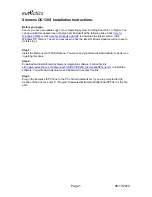
placed:
•
At left margin
- Places characters flush against the left margin of the editor window, as shown in the
previous example. The indent levels are not changed. This provides better visibility for your com-
ments and a way to clearly see the indent level relative to lines that are not commented out.
•
At level of indent
- Places and aligns characters vertically at the current indent level. For example:
//if (!enabled) {
//
tabState = TIS_DISABLED;
//}
•
Start in column
- Specifies in which column to start the comment for a line selection. This is useful
for column-oriented languages such as COBOL. Type or use the spin box to select the desired
column number. The left comment characters are placed at the specified column.
Doc Comments
Select from the following options:
•
Automatically expand doc comments
- When this option is selected, SlickEdit
®
Core automatically
inserts a skeleton doc comment when you type comment start characters and then press
Enter
on a
line directly above a function, class, or variable. The type of skeleton that is inserted is based on your
start characters and style settings (specified in the
For start characters
and
Use style
boxes).
Note
In C#, you do not need to press
Enter
, as the skeleton comment is inserted after you type the
third slash.
•
Insert leading *
- If selected, when you press
Enter
inside a doc comment, a leading asterisk is auto-
matically inserted on the next line. For example:
/**
* This is my comment.[CURSOR HERE]
*/
Pressing
Enter
will result in:
/**
* This is my comment.
* [CURSOR HERE]
*/
•
For start characters
- Use this box to specify the comment start characters that will trigger the style of
reference tags that are automatically inserted as part of the doc comment skeleton. The characters se-
lected here use the reference tag style specified in the
Use style
box. For comments formatted in
Extension Options Dialog
409
Summary of Contents for Corev3.3 for Eclipse
Page 1: ...Think Slick Corev3 3 for Eclipse...
Page 2: ......
Page 3: ...SlickEdit Core v3 3 for Eclipse...
Page 5: ......
Page 6: ......
Page 14: ...xii...
Page 20: ...xviii...
Page 22: ...xx...
Page 23: ...Chapter 1 Introduction 1...
Page 41: ...Chapter 3 User Interface 19...
Page 61: ...Chapter 4 User Preferences 39...
Page 80: ...BODY BODY HTML HTMLEOF Restoring Settings on Startup 58...
Page 82: ...60...
Page 83: ...Chapter 5 Context Tagging 61...
Page 97: ...Chapter 6 Editing Features 75...
Page 124: ...Code Templates 102...
Page 238: ...Figure 6 49 Test Parsing Configuration Example 1 C Refactoring 216...
Page 241: ...Figure 6 51 Test Parsing Configuration Example 3 Reviewing Refactoring Changes 219...
Page 250: ...228...
Page 251: ...Chapter 7 Language Specific Editing 229...
Page 328: ...306...
Page 329: ...Chapter 8 Tools and Utilities 307...
Page 350: ...328...
Page 351: ...Chapter 9 Macros and Macro Programming 329...
Page 360: ...338...
Page 361: ...Chapter 10 SlickEdit Core Dialogs 339...
Page 375: ...Find and Replace View 353...
Page 491: ...Chapter 11 Appendix 469...
Page 567: ......
Page 568: ......
















































